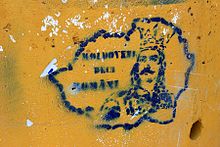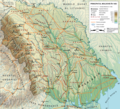Movement to unite Romania and Moldova
The movement for the unification of Romania and Moldova originated in the phase of perestroika , when the local elites, mainly the Moldovan national movement, gained increasing political freedom in Chișinău . The independence movement in Moldova was split from the beginning, into those who saw Moldova as a separate state and those who called for unification with Romania . After the independence of the state as a result of the dissolution of the Soviet Union , the movement for the unification of Romania and Moldova gained popularity, but could not prevail against the efforts towards statehood (Moldovenism) of the Moldovan elite and lost its importance towards the end of the 1990s.
origin
The Principality of Moldova originally comprised areas that today belong to Romania ( West Moldova ) and the Republic of Moldova ( Bessarabia / East Moldova). In 1812 ( Peace of Bucharest ), Bessarabia was transferred to Russia by the Ottoman Empire. When the Romanian principalities of Moldova and Wallachia were united in 1859, the eastern part of Moldova was therefore excluded. Bessarabia was occupied by Romania during the First World War in 1918. After the Second World War , Romania had to cede Bessarabia to the Soviet Union (first in 1940; finally from 1944; formally from 1947 in the Paris Peace Conference ). In 1991 Moldova became independent.
After the end of the USSR
The Moldovans speak the Romanian language and are ethnically and culturally part of the Romanian people . They make up the absolute majority of the country's population . In the cities and in the Transnistrian part of the country they have the relative majority (40% in 1989), but Russians and Ukrainians make up the vast majority of the remaining population . This territory lies to the east of the Dniester River , which formed the eastern border of the Principality of Moldova until 1812, and was under Romanian administration between 1941 and 1944, as part of the Transnistrian Governorate .
On May 6, 1990 , large demonstrations were organized on both banks of the Prut River , which represented the border between Romania and the Moldovan Soviet Republic, in which hundreds of thousands of demonstrators from both countries took part. These demonstrations went down in history under the name "Podul de Flori" (translated: "The Flower Bridge"). The border, which for decades was open almost exclusively to goods traffic during the Soviet rule, as human contacts were deliberately interrupted on both sides, was opened at eight border crossings (Miorcani-Pererita, Stânca-Costești, Sculeni- Sculeni , Ungheni- Ungheni , Albița-Leușeni, Fălciu-Stoianovca, Oancea- Cahul and Galați - Giurgiulești ). Separated families were able to reunite after a decade-long separation and a mood arose that was reminiscent of the fall of the Berlin Wall . A similar demonstration was organized on June 16, 1991.
After the Soviet Union dissolved in 1991 , the Moldovan Popular Front demanded that Romania and Moldova unite according to the German model. In Moldova today this is mainly supported by the Liberal and Christian Democratic Parties , while the Communist Party is openly against it.
The fear of a possible unification of Moldova and Romania was one reason for the separation of the separatist region of Transnistria from Moldova. The Russians and Ukrainians living there rejected such an association and feared that they would be marginalized in Greater Romania and no longer be able to represent their interests effectively.
Development since 2000
At the end of 2005, Romanian President Traian Băsescu proposed such an association to his Moldovan counterpart Vladimir Voronin , but the Moldovan side rejected it. In a poll in Moldova in November 2006, 48% of respondents had expressed a desire to become Romanian citizens, while 46% were against and another 5% were undecided. In a survey conducted in Romania in March 2006, 51% of respondents expressed a desire to unite, while 27% were in favor of maintaining the current situation.
After the Moldovan parliamentary elections in April 2009 , the debate about a possible unification of the two states flared up again. The ruling communists accused the opposition of being paid by Romania and of wanting to give up Moldova's statehood. In view of the persistently poor economic situation in Moldova, exacerbated by the global economic crisis , the desire for rapprochement with the European Union and its member state Romania grew in the Moldovan population . Numerous Romanian flags were seen during the protests against the suspected election fraud .
On April 17, 2011, a group of non-governmental organizations (NGOs) and other initiatives from Romania and Moldova founded the Civic Platform Action 2012 (Acțiunea 2012) to support the process of unifying the two states. The organization is led by the journalist George Simion (born 1986). After Simion called for a large demonstration on May 16, 2015 for “accelerating the EU integration of the Republic of Moldova through unification with Romania”, he was expelled from the country. According to a representative of the Moldovan Ministry of Interior and the Migration and Asylum Authority, Simion, who has Moldovan and Romanian citizenship, will not be allowed to return to Moldova for the next five years.
In 2014, the percentage of those who were in favor of reunification was only 15 to 20 percent. In recent years, the Republic of Moldova has seen an increase in those who wish to be reunited with Romania. A survey from September 2019 found that 30% of the population of Moldova are in favor of reunification with Romania and 60% are against. In June 2020, approval rose to 37%.
cards
Romania before the Berlin Congress , 1878
Romania (1918–1940) and the MASSR (1924–1940)
Romania after the Paris Peace Conference (1947) compared to the pre-war period
literature
- Lenore A Grenoble: Language Policy in the Soviet Union. Springer, 2003, ISBN 1-4020-1298-5 .
- Peter Cross John Mackinlay: Regional Peacekeepers. United Nations University Press, 2003, ISBN 92-808-1079-0 .
- Stefan Troebst: The Transnistrian conflict and its handling by the OSCE. In: African Perspectives - Theory and Practice of Civil Conflict Management in Eastern Europe. Rüegger Verlag, Zurich 1998, ISBN 3-7253-0604-4 , pp. 347-382.
- Kilian Graf: The Transnistria conflict: product of late Soviet distribution struggles and disintegration conflict of the imploded Soviet Union. Disserta-Verlag, Hamburg 2010, ISBN 978-3-942109-30-7 .
Web links
- Acțiunea 2012
- Protests la Chișinău și București, după expulzarea liderului organizației unioniste Acțiunea 2012
- Un interviu cu George Simion (Hotnews.ro)
Individual evidence
- ↑ Stefan Ihrig: Rediscovering History, Rediscovering Ultimate Truth History, Textbooks, Identity and Politics in Moldova (PDF; 277 kB)
- ↑ George Damian: President proposed unification with Basarabia. ZIUA, July 3, 2006.
- ↑ Unul din doi moldoveni vrea cetatenie romana. BBC, December 11, 2006.
- ↑ Romanians want Basarabia to unify with Romania. ZIUA, April 3, 2006.
- ^ "Republic of Moldova expelled unionist activists from the country" , in: Tiroler Tageszeitung Online , May 13, 2015.
- ↑ Sondaj // 30%, deciși să voteze Unirea R. Moldova cu România , deschide.md, September 26, 2019.
- ↑ Sondaj // CRESTE Numarul unioniştilor. 37% before Unirea cu România , deschide.md, June 2, 2020.














